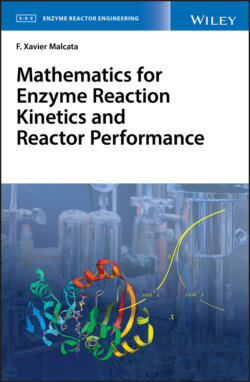Читать книгу Mathematics for Enzyme Reaction Kinetics and Reactor Performance - F. Xavier Malcata - Страница 53
4.6.2 Positive Semidefinite Matrix
ОглавлениеA (real) symmetric, positive semidefinite (n × n) matrix V satisfies the condition
(4.196)
for any real (n × 1) vector a – irrespective of size or type of V, and of magnitude or sign of its elements, as long as the said product can be calculated; it should be emphasized that aT Va represents a scalar. In the case of V being symmetric – and recalling the multiplication of any significant vector by a null matrix as per Eq. (4.67), one readily finds that
(4.197)
because Va =0n×1 implies aT 0n×1 = 0 in general. To show the converse, one may resort to any form of column vector en lieu of a, namely, that obtained from addition of λb to a – with b denoting a vector of appropriate dimensions and λ denoting a scalar; a quadratic polynomial P{λ} may accordingly be defined as
(4.198)
while
(4.199)
in view of Eq. (4.196) – with no restriction imposed upon column vector a, or a + λb, for that matter. Algebraic expansion of Eq. (4.198) leads to
(4.200)
at the expense of Eqs. (4.24), (4.34), (4.76), (4.82), (4.114), and (4.123); as V is, by hypothesis, symmetric, one may resort to Eq. (4.195) to transform Eq. (4.200) to
(4.201)
also with the aid of the commutativity and associativity of addition of scalars. Since P{λ} cannot change sign as per Eq. (4.199) when λ spans the whole real domain, then its sign should remain that of the coefficient of λ2 – as will be seen later, when dealing with the roots of a quadratic equation. In fact, absence of real distinct roots (as entertained by P{λ} ≥ 0 implies one of two possibilities: either a set of conjugate complex roots, say, r1 = α + ιβ and r2 = α − ιβ – so Eq. (2.182) indicates that P{λ} = a2(λ − r1)(λ − r2), or else P{λ} = a2(λ − (α + ιβ))(λ − (α − ιβ)) = a2((λ − α) − ιβ)((λ − α) + ιβ), where the said product of two conjugate binomials reduces to P{λ} = a2((λ − α)2 − ι2 β2), or P{λ} = a2((λ − α)2 + β2) since −ι2 = 1, with (λ − α)2 + β2 > 0 for being the sum of two squares; or a double root r – in which case P{λ} = a2(x − r)2 is also based on Eq. (2.182). In either case, the factor multiplying a2 being positive will be unable to change the sign brought about by a2. Moreover, V is positive semidefinite by hypothesis, so aT Va is nonnegative in agreement with Eq. (4.196) – and exchange of a with any other (compatible) vector b will also lead to bT Vb ≥ 0, as expected. No distinct real roots can exist for P{λ}, so its discriminant binomial, ΔP, must be negative or nil, i.e.
(4.202)
– where 4 was meanwhile factored out and the associative property of the multiplication of scalars duly utilized; if aT Va = 0 as stated in Eq. (4.197), then Eq. (4.202) reduces to
(4.203)
that implies
(4.204)
because any other value of bT Va would make the left‐hand side positive for it being a square. Equation (4.204) implies, in turn,
(4.205)
since no restriction was imposed on b; therefore, aT Va = 0 implies Va =0n×1, besides Va =0n×1 implying aT Va = 0, as seen previously – so Va =0n×1 and aT Va = 0 are equivalent statements. Consequently, Va ≠0n×1 accounts for the inequality case in Eq. (4.196), i.e. aT Va > 0.
If P denotes an (n × m) matrix, then the (m × m) matrix PT VP is (real) symmetric, positive semidefinite; in fact,
(4.206)
as per Eqs. (4.110) and (4.120) – so PT VP abides to the symmetry requirement because, by hypothesis, VT = V, i.e.
(4.207)
Furthermore, the scalar
(4.208)
– where a and b denote (m × 1) and (n × 1) column vectors, respectively, and Eqs. (4.57) and (4.120) were taken advantage of, will be positive if b ≡ Pa ≠ 0n × 1 and nil if b ≡ Pa = 0n × 1, in agreement with the foregoing derivation, coupled with Eqs. (4.196) and (4.197); this is so because V is positive semidefinite by hypothesis. In other words,
(4.209)
– which, together with Eq. (4.207), confirms the full original statement on PT VP, i.e. a symmetric and positive definite matrix.
In the particular case of V = In, Eq. (4.196) degenerates to
(4.210)
at the expense of the n‐dimensional analogue of Eq. (3.8) – with the aid of Eq. (4.64) and explicitation of (n × 1) matrix a; hence, In is positive semidefinite as per Eq. (4.196). One may therefore resort directly to Eq. (4.209) to write
(4.211)
encompassing (m × 1) matrix a; and Eq. (4.211) may be algebraically simplified to
(4.212)
in view of Eq. (4.64). Inspection of Eq. (4.212) confirms that PT P is necessarily a positive semidefinite matrix, while
(4.213)
as per Eq. (4.120), or else
(4.214)
in view of Eq. (4.110) – thus confirming its symmetry.
